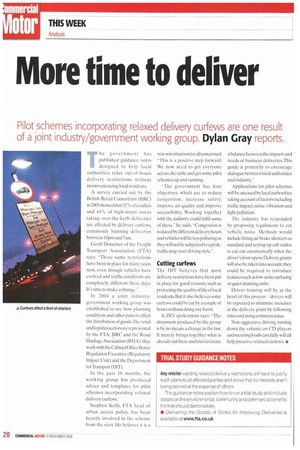More time to deliver
Page 20

If you've noticed an error in this article please click here to report it so we can fix it.
Pilot schemes incorporating relaxed delivery curfews are one result of a joint industry/government working group. Dylan Gray reports.
The government has published guidance notes designed to help local authorities relax out-of-hours delivery restrictions without inconveniencing local residents.
A survey carried out by the British Retail Consortium ( BRC) in 2005 showed that 32% of retailers and 44% of high-street stores taking over-the-kerb deliveries are affected by delivery curfews, commonly banning deliveries between lOpm and 7am.
Geoff Dossetter of the Freight Transport Association ( FTA) says: "These same restrictions have been in place for many years now, even though vehicles have evolved and traffic conditions are completely different these days. Its time to make a change."
In 2004 a joint industry/ government working group was established to see how planning conditions and other powers affect the distribution of goods.The retail and logistics sectors are represented by the FTA. BRC and the Road Haulage Association (RI IA): they work with the Cabinet Office Better Regulation Executive (Regulatory Impact Unit) and the Department for Transport ( DfT).
In the past 18 months, the working group has produced advice and templates for pilot schemes incorporating relaxed delivery curfews.
Stephen Kelly, FTA head of urban access policy, has been heavily involved in the scheme from the start. He believes it is a win-win situation for all concerned: "This is a positive step forward. We now need to get everyone across the table and get some pilot schemes up and running.
"'the government has four objectives, which are to reduce congestion, increase safety, improve air quality and improve accessibility. Working together with the industry could fulfil some of these." he adds. --Congestion is reduced by different delivery hours and vehicles will be less polluting as they will not be subjected tea peaktraffic stop-start driving style."
Cutting curfews The MT believes that most delivery restrictions have been put in place for good reasons, such as protecting the quality of life of local residents. But it also believes some curfews could be cut by a couple of hours without doing any harm.
A Dn. spokesman says: "The document produced by the group is by no means a change in the law. It merely brings together what is already out there and tries to create
a balance between the impacts and needs of business deliveries. This guide is primarily to encourage dialogue between local authorities and industry."
Applications for pilot schemes will be assessed by local authorities, taking account of factors including trafiic impact, noise, vibration and light pollution.
The industry has responded by proposing regulations to cut vehicle noise. Methods would include fitting air brake silencers as standard and setting up cab radios to cut out automatically when the driver's door opens.Delivery points will also be taken into account:they could be required to introduce features such as low-noise surfacing or quiet shunting units.
Driver training will he at the heart of this process drivers will be expected to minimise nuisance at the delivery point by following rules and usi ng common sense.
Non-aggressive driving, turning down the volume on CD players and securing loads carefully will all help preserve relaxed curfews. •






























































































































































































